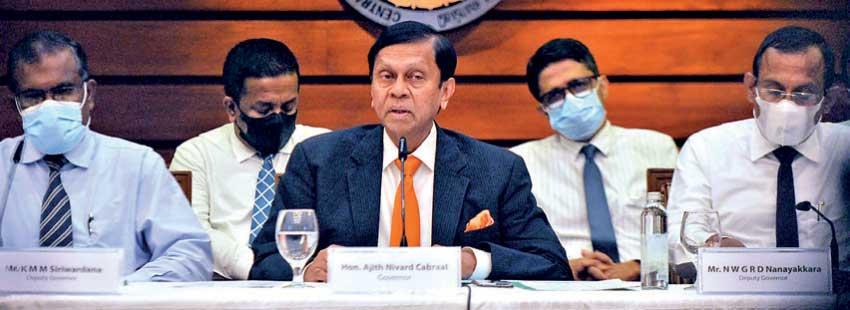Reply To:
Name - Reply Comment

CBSL Governor Ajith Nivard Cabraal briefing the media on the monitory policy decisions taken on Thursday - Pic By Nisal Baduge
The Central Bank of Sri Lanka (CBSL) raised its key policy rates by 100 basis points, delivering its highest rate hike in more than a dozen years and raised selected administrative rates by 200 basis points effective immediately.
It also recommended an eight-point policy package to the government to complement with the monetary policy, in an effort to alleviate the prevailing economic crisis.
At the meeting held on Thursday the Monetary Board raised both the Standing Deposit Facility Rate (SDFR) and the Standing Lending Facility Rate (SLFR) by 100 basis points each to 6.50 percent and 7.50 percent respectively, clearing the path for further rise in lending and deposit rates in the economy.
The size of the policy rate hike might have taken many analysts by surprise who were largely betting on a half a percentage point hike. It reflects how deeper the issues in the external sector and the real economy run.
“Considering the severity of the external shocks and continued disruptions to domestic economic activity, the Monetary Board was of the view that a comprehensive policy package containing both traditional and non-traditional measures, along with other initiatives that have an impact on the overall economy, is essential to counter such economic headwinds,” the Central Bank said. Sri Lanka is confronted with its worst foreign exchange crisis in its recent history, spilling over into fuel and other commodities shortages and daily blackouts, which have inconvenienced the general public and the industries.
While the objective of Thursday’s decisions is to absorb currency in circulation into savings and thereby ease the aggregate demand, which in turn could cool down the consumption demand and thus the merchandise imports, the economic analysts are less convinced.
“While a 100 basis point increase is welcome from the Monetary Board, this isn’t going to be enough,” said one economic analyst.
“With the entrenched inflationary pressures, the impending steep rise in dollar yields and the prevailing dollar shortage which is unlikely to go away anytime soon barring the realisation of the envisaged inflows, I think we are looking at another 100 to 200 basis point increase in key policy rates in the remainder of the year,” he said, adding that tweaking rates alone would not resolve all the problems.
The International Monetary Fund (IMF) and other economic analysts have been calling for a gradual floating of the currency to end the dollar shortage plaguing the country and also to recoup reserves.
Meanwhile, in another macro-prudential measure, the CBSL raised the administrative rates of credit cards, pre-arranged temporary overdrafts and pawning advances by 200 basis points to 20 percent, 18 percent and 12 percent per annum.
“The Monetary Board was of the view that the above measures will dampen the possible build-up of underlying demand pressures in the economy, which would, in turn, help ease pressures in the external sector, thus promoting greater macroeconomic stability”, the Monetary Board said.